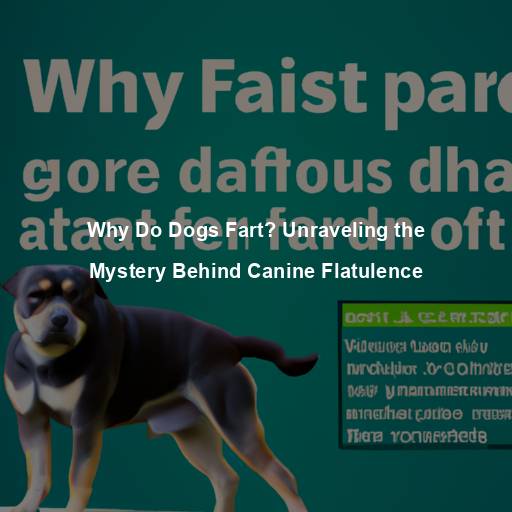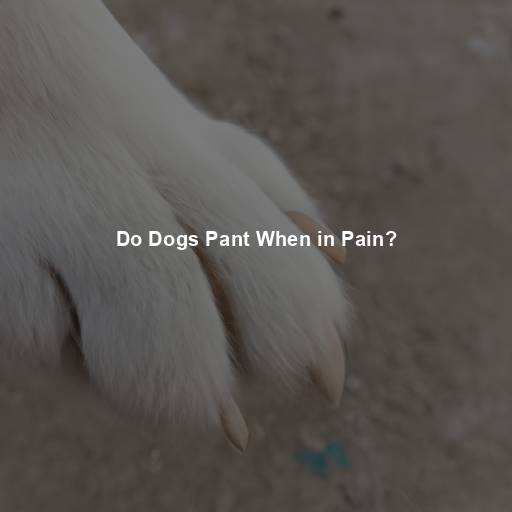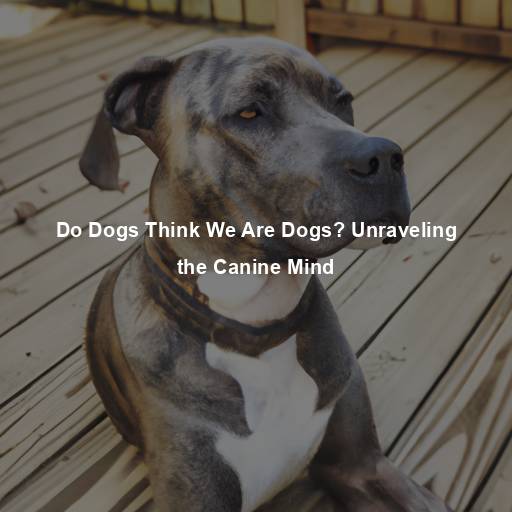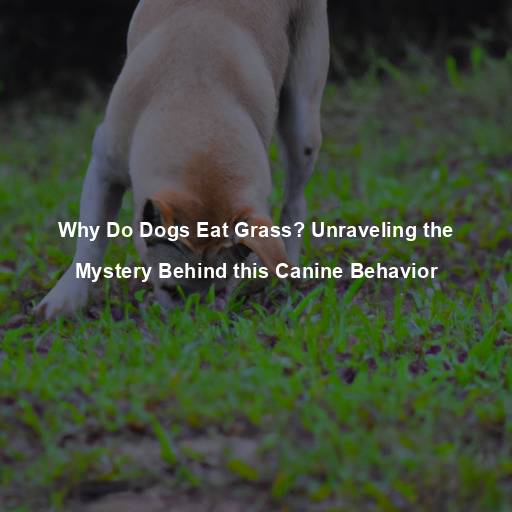Why Do Dogs Fart? Unraveling the Mystery Behind Canine Flatulence
Last Updated on August 4, 2023 by Evan
Contents [hide]
- 1 The Curious Case of Canine Flatulence: Unmasking the Silent Culprit
- 1.1 The Anatomy of Flatulence: Understanding the Inner Workings
- 1.2 The Culinary Culprits: Diet and Digestion
- 1.3 When Flatulence Signals a Deeper Issue: Health Concerns
- 1.4 Tackling the Toots: Tips for Reducing Canine Flatulence
- 1.5 Embracing the Quirks: Celebrating Our Canine Companions
- 1.6 Unmasking the Culprits: Factors Influencing Canine Flatulence
- 1.6.1 Swallowed Air: Dogs who are prone to gulping down their food or those who excessively pant or chew on toys may swallow more air, leading to increased flatulence.
- 1.6.2 Bacterial Imbalance: Just like humans, dogs have a delicate balance of bacteria in their digestive systems. Disruptions in this balance, such as an overgrowth of certain bacteria, can result in excessive gas production.
- 1.6.3 Digestive Disorders: Dogs with underlying digestive disorders, such as inflammatory bowel disease or gastrointestinal infections, may experience chronic flatulence.
- 1.6.4 Age and Breed: Certain breeds, such as Bulldogs or Pugs, are predisposed to flatulence due to their unique anatomical features, including shorter snouts and compressed gastrointestinal tracts. Additionally, puppies and senior dogs may be more prone to gas due to their developing or aging digestive systems.
- 1.7 Unveiling the Aromas: The Smell of Canine Flatulence
- 1.7.1 Dietary Components: Certain foods, such as those containing sulfur compounds (e.g., cabbage, broccoli, or high-sulfur proteins), can contribute to a more pungent odor when broken down in the digestive system.
- 1.7.2 Bacterial Activity: The types and amounts of bacteria present in a dog’s gut can impact the odor of their flatulence. Some bacteria produce gases with distinct odors, contributing to the unique scent of each dog’s gas.
- 1.7.3 Digestive Efficiency: Dogs with digestive disorders or compromised digestive systems may have difficulties fully breaking down food. This incomplete digestion can lead to the production of foul-smelling gases.
- 1.8 Farting Frenzy: When to Seek Veterinary Assistance
- 1.8.1 Severe Discomfort: If your dog appears to be in significant pain or discomfort, exhibits signs of abdominal bloating, or displays unusual behavior alongside excessive flatulence, it’s crucial to seek immediate veterinary attention.
- 1.8.2 Changes in Stool: Frequent diarrhea, bloody stools, or sudden changes in bowel movements accompanied by increased flatulence may indicate an underlying gastrointestinal problem.
- 1.8.3 Weight Loss or Lack of Appetite: Unexplained weight loss or a sudden decrease in appetite, coupled with excessive flatulence, could be signs of an underlying health issue that requires veterinary evaluation.
- 1.8.4 Vomiting: Persistent vomiting alongside flatulence may indicate a more serious gastrointestinal problem that should be addressed by a veterinarian.
- 1.9 Minimizing the Symphony: Strategies for Reducing Canine Flatulence
- 1.9.1 Avoid Overfeeding: Feeding your dog appropriately sized meals can help prevent overeating, reduce the likelihood of gulping air, and promote healthier digestion.
- 1.9.2 Regular Exercise: Engaging your dog in regular physical activity not only supports overall well-being but also aids in maintaining a healthy digestive system.
- 1.9.3 Quality Diet: Opt for high-quality dog food that suits your dog’s specific nutritional needs. Consult with your veterinarian to determine the best dietary options for your furry friend.
- 1.9.4 Slow Transition: When introducing a new diet or changing your dog’s food, do so gradually over several days to allow their digestive system to adapt and minimize the chances of excessive gas.
- 1.9.5 Monitor Treats: Keep an eye on the type and quantity of treats you give your dog, as some treats may contain ingredients that contribute to flatulence.
- 1.9.6 Stress Reduction: Dogs, like humans, can experience stress, which can impact their digestive health. Creating a calm and comfortable environment can help minimize stress-related flatulence.
- 1.10 The Farting Finale: Embracing Our Canine Companions, Noisy Toots and All
- 2 FAQs – Why do dogs fart?
The Curious Case of Canine Flatulence: Unmasking the Silent Culprit
Dogs are known for their unwavering loyalty, boundless energy, and adorable antics that effortlessly warm our hearts. However, there is one aspect of our furry friends that can leave us questioning their innocence – their propensity to emit noxious gases. Yes, we’re talking about dog farts! Have you ever found yourself pondering over the reasons behind this peculiar phenomenon?
The Anatomy of Flatulence: Understanding the Inner Workings
As we delve into the perplexing world of canine flatulence, let us first grasp the intricate science at play. Dogs, much like humans, possess a fascinatingly complex digestive system that tirelessly works to break down food and extract vital nutrients. From the moment they devour their meals, the journey begins, starting in their mouths and meandering through their stomachs and intestines. Within this labyrinthine process, microscopic bacteria residing in the gut mysteriously ferment specific food elements, manufacturing peculiar gaseous companions like methane and hydrogen sulfide.
The Culinary Culprits: Diet and Digestion
Now that we have a grasp on the inner workings, let’s explore the primary factors that contribute to canine flatulence. One of the most significant influencers is diet. Just like humans, dogs can experience gas build-up when consuming certain types of food. Here are a few common dietary factors that may contribute to farting in dogs:
-
High-Fiber Foods: A diet rich in fiber, such as certain vegetables or grains, can lead to increased gas production. While fiber is essential for a healthy digestive system, excessive intake can result in more frequent flatulence.
-
Fast Eating Habits: Dogs that gulp down their food quickly may also inhale air along with their meals. This air can get trapped in the gastrointestinal system, leading to increased flatulence.
-
Food Allergies or Intolerances: Just like humans, dogs can develop allergies or intolerances to certain foods. These sensitivities can disrupt the digestive process and result in excessive gas production.
All Paws In: We all know the irresistible urge to share a delicious meal with our furry friends, but when it comes to certain human delicacies, caution is essential. Give a second thought before tossing them table scraps, as some human foods might leave your dogs in a state of tummy turmoil! Foods like onions, garlic, or dairy products may pose a perplexing challenge to their delicate digestion, resulting in a not-so-pleasant aftermath of increased flatulence. So, let’s keep our pup’s tummies happy and avoid any unexpected bursts of gas by sticking to pup-approved treats!
When Flatulence Signals a Deeper Issue: Health Concerns
Experiencing occasional bodily emissions is a natural occurrence, but the consistent release of particularly odorous gases may signify an underlying health condition. Should you detect any of the subsequent symptoms in conjunction with frequent flatulence, it becomes imperative to seek guidance from a veterinarian:
-
Abdominal Pain: Dogs experiencing discomfort, bloating, or pain in the abdominal region alongside excessive flatulence may require medical attention.
-
Vomiting or Diarrhea: Consistent vomiting or diarrhea paired with increased flatulence could indicate an underlying gastrointestinal issue.
Does your furry companion seem unusually disinterested in meals? Has your loyal pet been shedding pounds without any apparent reason? These perplexing changes in appetite and unexplained weight loss could be indicators of an underlying health issue that requires prompt attention from a qualified veterinarian. Don’t delay – reach out to the experts to ensure your beloved dog’s wellbeing.
Are your furry friends showing signs of behavior that leave you scratching your head in confusion? Rest assured, there might be more to it than meets the eye! If you’ve noticed your beloved canine companions displaying inexplicable lethargy, restlessness, or discomfort, don’t simply dismiss it as a case of regular flatulence. Dive into the perplexing world of dog behavior and uncover the hidden secrets behind their mysterious actions.
Just as every furry companion is as distinctive as a fingerprint, the symphony of sounds and odors that emanate from their hindquarters can leave even the most astute pet parent perplexed. However, one mustn’t underestimate the importance of seeking expert advice when it comes to our four-legged friend’s digestive well-being. From dietary habits to underlying health conditions, a professional’s guidance can help unravel the mysteries of canine flatulence and put your worries to rest.
Tackling the Toots: Tips for Reducing Canine Flatulence
After delving into the sources of those unmistakable odors and the potential impact on our well-being, it’s time to shift our focus towards pragmatic solutions to curb canine flatulence.
Dietary Adjustments:
Smooth Transitions: Helping your furry friend embrace a new diet requires a gentle approach, allowing their delicate digestive system to adapt and reducing any unwelcome surprises in the air.
- Low-Fiber Options: If your dog experiences excessive gas with a high-fiber diet, consider shifting to a low-fiber alternative.
Discover the key to a gaseous relief with our latest revelation on protein sources. Unleash the power of novelty as we delve into the enchanting realms of fish and venison, showcasing their ability to offer respite from the torment of food allergies and sensitivities. Navigate through the perplexing world of digestive discomfort and let these alternative protein sources be your guiding light towards a more serene existence. Say goodbye to the noxious effects of flatulence as you embark on this burst of dietary enlightenment.
Mealtime Etiquette:
Do you ever find yourself puzzled about how to get your furry friend to slow down and savor their meals? Well, fret no more! We’ve discovered a clever solution that will have your dog relishing every bite instead of gulping down their food like it’s going out of style. Introducing specialized slow-feeding bowls and feeding puzzles, designed to transform your dog’s mealtime experience and curb the amount of air they swallow in the process.
It can be quite hard to resist the urge to share our delicious meals with our adorable furry companions. However, it’s essential to remember that certain foods can have a rather unpleasant effect on their digestive systems, causing them to let loose the smelly beast known as flatulence. So, in order to save your pet from unnecessary discomfort and create a more pleasant atmosphere in your home, it’s best to resist the temptation to offer them any table scraps. They may beg with those big, innocent eyes, but trust me, it’s for their own well-being.
Monitoring and Care:
-
Exercise: Regular physical activity helps stimulate digestion and can reduce the likelihood of flatulence.
-
Regular Vet Visits: Routine check-ups with your veterinarian are essential to monitor your dog’s overall health and address any concerns promptly.
-
Probiotic Supplements: Consult with your veterinarian about the potential benefits of probiotic supplements in promoting a healthy digestive system.
Embracing the Quirks: Celebrating Our Canine Companions
While canine flatulence may sometimes catch us off guard, it’s important to remember that our furry friends bring immeasurable joy and companionship to our lives. Their unique quirks and occasional gas emissions are simply a part of who they are. By understanding the causes behind canine flatulence and taking appropriate measures to minimize discomfort, we can continue to cherish the incredible bond we share with our beloved dogs.
So, the next time you find yourself pondering the mysteries of doggy farts, take a moment to appreciate the unconditional love and happiness our four-legged friends bring into our lives. After all, a little bit of flatulence is a small price to pay for the immense joy and companionship they provide us every day.
Stay tuned for more intriguing articles on PetsRoof.com, where we explore the fascinating world of pets, one wag, purr, and chirp at a time!## The Silent Symphony of Doggy Flatulence: A Deeper Dive into Canine Gas Production
Unmasking the Culprits: Factors Influencing Canine Flatulence
As we delve into the mysterious world of canine flatulence, it becomes evident that there exist intriguing other elements that lend a hand in our furry companions unleashing their toots. It is in these elusive factors that the true essence of gas expulsion lies, waiting to be unraveled. So, without further ado, let us embark on a quest to unravel these mysterious contributors to the symphony of doggy flatulence.
Swallowed Air: Dogs who are prone to gulping down their food or those who excessively pant or chew on toys may swallow more air, leading to increased flatulence.
Bacterial Imbalance: Just like humans, dogs have a delicate balance of bacteria in their digestive systems. Disruptions in this balance, such as an overgrowth of certain bacteria, can result in excessive gas production.
Digestive Disorders: Dogs with underlying digestive disorders, such as inflammatory bowel disease or gastrointestinal infections, may experience chronic flatulence.
Age and Breed: Certain breeds, such as Bulldogs or Pugs, are predisposed to flatulence due to their unique anatomical features, including shorter snouts and compressed gastrointestinal tracts. Additionally, puppies and senior dogs may be more prone to gas due to their developing or aging digestive systems.
Unveiling the Aromas: The Smell of Canine Flatulence
When it comes to the world of doggy flatulence, there’s more than meets the ear. We all know that distinctive sound, but the smell? That’s a whole other ball game. Brace yourself for a symphony of scents, because the intensity and aroma of a dog’s gas can take your olfactory senses on a wild ride.
Dietary Components: Certain foods, such as those containing sulfur compounds (e.g., cabbage, broccoli, or high-sulfur proteins), can contribute to a more pungent odor when broken down in the digestive system.
Bacterial Activity: The types and amounts of bacteria present in a dog’s gut can impact the odor of their flatulence. Some bacteria produce gases with distinct odors, contributing to the unique scent of each dog’s gas.
Digestive Efficiency: Dogs with digestive disorders or compromised digestive systems may have difficulties fully breaking down food. This incomplete digestion can lead to the production of foul-smelling gases.
Farting Frenzy: When to Seek Veterinary Assistance
Sometimes our furry friends experience a level of tooting that is perfectly harmless, but there are instances when an abundance of gas may require a trip to the veterinary clinic. If you happen to notice any of the following indications, it could be a clue that there might be an underlying problem at play:
Severe Discomfort: If your dog appears to be in significant pain or discomfort, exhibits signs of abdominal bloating, or displays unusual behavior alongside excessive flatulence, it’s crucial to seek immediate veterinary attention.
Changes in Stool: Frequent diarrhea, bloody stools, or sudden changes in bowel movements accompanied by increased flatulence may indicate an underlying gastrointestinal problem.
Weight Loss or Lack of Appetite: Unexplained weight loss or a sudden decrease in appetite, coupled with excessive flatulence, could be signs of an underlying health issue that requires veterinary evaluation.
Vomiting: Persistent vomiting alongside flatulence may indicate a more serious gastrointestinal problem that should be addressed by a veterinarian.
Minimizing the Symphony: Strategies for Reducing Canine Flatulence
Reducing our furry friend’s gas emissions may prove to be an elusive goal, but fret not, for we have curated a collection of practical measures to tame the odious occurrence. Brace yourself for a plethora of unexpected tactics, such as altering their diet, introducing probiotics, and even seeking professional advice. Embrace the challenge and embark on a pungent-pet journey like no other, as we navigate through the aromatic labyrinth of flatulence management.
Avoid Overfeeding: Feeding your dog appropriately sized meals can help prevent overeating, reduce the likelihood of gulping air, and promote healthier digestion.
Regular Exercise: Engaging your dog in regular physical activity not only supports overall well-being but also aids in maintaining a healthy digestive system.
Quality Diet: Opt for high-quality dog food that suits your dog’s specific nutritional needs. Consult with your veterinarian to determine the best dietary options for your furry friend.
Slow Transition: When introducing a new diet or changing your dog’s food, do so gradually over several days to allow their digestive system to adapt and minimize the chances of excessive gas.
Monitor Treats: Keep an eye on the type and quantity of treats you give your dog, as some treats may contain ingredients that contribute to flatulence.
The Farting Finale: Embracing Our Canine Companions, Noisy Toots and All
While doggy flatulence can be amusing or even embarrassing at times, it’s essential to remember that it’s a natural byproduct of the digestive process. Understanding the factors that contribute to canine flatulence allows us to take appropriate measures to minimize any discomfort our furry friends may experience. Embrace the quirks and idiosyncrasies of your canine companion, knowing that their unconditional love and loyalty far outweigh the occasional gas-filled symphony they produce.
Stay connected with PetsRoof.com for more enlightening articles and helpful tips on all things pets. Together, we celebrate the wonderful world of our beloved furry companions!
FAQs – Why do dogs fart?
Why do dogs fart?
As creatures sharing this earthly realm, dogs too engage in a rather mystifying natural act – the release of gas. When our canine counterparts indulge in a delectable feast, a bewildering series of chemical reactions commence within their digestive system, orchestrating the breakdown of nutrients and liberation of energy. Intriguingly, amidst this remarkable gastronomic symphony, a side-effect emerges – the birth of gas, which can ultimately lead to the perplexing phenomenon we humans know as flatulence.
What causes dogs to fart?
Dogs, just like us, have their own unique set of fart-inducing factors that might leave us in perplexity. The first culprit on this stinky list is undoubtedly their dietary choices. Foods rich in fiber like beans or soy can turn their tummies into gas factories, making every room they enter an experience of unexpected burstiness. Besides, those pampered pooches who indulge in a high-fat diet may suffer from excessive tooting sessions, leaving their human counterparts bewildered. Moreover, the way they devour their meals can contribute to their gassy encounters; swallowing air while gobbling or drinking at the speed of lightning can leave them with an unpleasant aftermath that might make even the most ardent dog lovers slightly perplexed.
Are certain dog breeds more prone to farting?
It’s a perplexing mystery that has left dog owners in a state of bewilderment – the connection between a dog’s breed and their propensity to emit pungent gas. While the evidence remains inconclusive, it appears that certain breeds may be more susceptible to gastrointestinal turmoil, resulting in an amplified gaseous symphony. The enigma deepens when we consider the brachycephalic breeds, characterized by their adorable flat faces. It seems that these precious pooches, such as Bulldogs and Pugs, may inadvertently consume extra air due to their unique facial structure, further fueling their reputation for unleashed flatulence. Moreover, it seems that the size of a canine companion plays a role in this enigmatic equation; larger breeds, along with those blessed (or cursed) with tender tummies, may encounter more digestive disturbances, leading to an increase in their odiferous emissions.
How can I reduce my dog’s farting?
Is your beloved canine companion emitting an excessive amount of gas? Fear not, for there are perplexing yet effective ways to alleviate their discomfort and reduce the burst of odorous emissions. Consider embarking on a culinary adventure with your trusted veterinarian by examining your dog’s diet and potentially transitioning to a high-quality, easily digestible feast that caters to their specific needs. By keeping a watchful eye on portion sizes and strategically eliminating gas-producing ingredients, you can navigate through this perplexing predicament. Encouraging regular exercise and curbing their enthusiasm for gobbling up food or water like there’s no tomorrow can also help minimize the amount of air they inadvertently swallow. However, should this conundrum persist or escalate, seeking guidance from a veterinarian is paramount in order to untangle any underlying health issues that may be causing this unpredictable mystery.
When should I be concerned about my dog’s farting?
Occasional farting is normal for dogs, but if you notice a sudden change or an excessive amount of gas, it may indicate an underlying problem. If your dog’s farting is accompanied by other symptoms such as bloating, diarrhea, vomiting, loss of appetite, or signs of pain, it is important to seek veterinary attention. These symptoms could be indicative of digestive issues, food intolerances, infections, or other health conditions that may require treatment.






